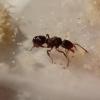I change my answer to likely Monomorium. There is no Podomyrma species imaged on AntWeb that has petiole nodes anywhere near as defined as these (they are much more thin and subtle). Its petiole nodes closely resemble that of most species of Monomorium and Solenopsis, but with Solenopsis ruled out because of the location, of course.
- Formiculture.com
- Forums
- Gallery
- Members
- Member Map
- Chat















